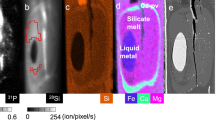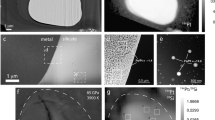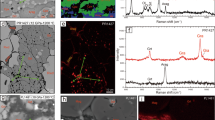Abstract
The high abundance of both nickel and cobalt and the chondritic Ni/Co ratio found in samples derived from the Earth's mantle are at odds with results from laboratory-based partitioning experiments conducted at pressures up to 27 GPa (refs 1,2). The laboratory results predict that the mantle should have a much lower abundance of both Ni and Co and a considerably lower Ni/Co ratio owing to the preferential partitioning of these elements into the iron core. Two models have been put forward to explain these discrepancies: homogeneous accretion3,6 (involving changes of the Ni and Co partition coefficients with oxygen and sulphur fugacities, pressure and temperature) and heterogeneous accretion7,9 (the addition of chondritic meteorites to the mantle after core formation was almost complete). Here we report diamond-cell experiments on the partitioning of Ni and Co between the main lower-mantle mineral ((Mg,Fe)SiO3-perovskite) and an iron-rich metal alloy at pressures up to 80 GPa (corresponding to a depth of ∼1,900 km). Our results show that both elements become much less siderophilic with increasing pressure, such that the abundance of both Ni and Co and the Ni/Co ratio observed in samples derived from the Earth's mantle appear to indeed be consistent with a homogeneous accretion model.
This is a preview of subscription content, access via your institution
Access options
Subscribe to this journal
Receive 51 print issues and online access
$199.00 per year
only $3.90 per issue
Buy this article
- Purchase on Springer Link
- Instant access to full article PDF
Prices may be subject to local taxes which are calculated during checkout



Similar content being viewed by others
References
Ringwood, A. E. Origin of the Earth and Moon 39 (Springer, New York, 1979).
Schmitt, W., Palme, H. & Wänke, H. Experimental determination of metal/silicate partition coefficients for P, Co, Ni, Cu, Ga, Ge, Mo, W. Geochim. Cosmochim. Acta 53, 173–185 (1989).
Ringwood, A. E. Origin of the Earth and Moon 122–134 (Springer, New York, 1979).
Murthy, R. V. Early differentiation of the Earth and the problem of mantle siderophile elements: A new approach. Science 253, 303–306 (1991).
Li, J. & Agee, C. B. Geochemistry of mantle-core formation at high pressure. Nature 381, 686–689 (1996).
Righter, K., Drake, M. J. & Yaxley, G. Prediction of siderophile element metal/silicate partition coefficients to 20 GPa and 2800 °C. Phys. Earth Planet. Inter. 100, 115–134 (1997).
Ringwood, A. E. Chemical evolution of the terrestrial planets. Geochim. Cosmochim. Acta 30, 41–104 (1966).
Turekian, K. & Clark, S. P. Inhomogeneous accumulation of the Earth from the primitive solar nebula. Earth Planet. Sci. Lett. 6, 346–348 (1969).
Wänke, H. Chemical composition and accretional history of terrestrial planets. Phil. Trans. R. Soc. Lond. A 325, 545–557 (1988).
O'Neill, H. St. C. & Palme, H. in The Earth's Mantle(ed. Jackson, I.) 3–123 (Cambridge Univ. Press, 1998).
Ohtani, E., Yurimoto, H. & Seto, S. Element partitioning between metallic liquid, silicate liquid, and lower mantle minerals: Implications for core formation of the Earth. Phys. Earth Planet. Inter. 100, 97–114 (1997).
Ohtani, E. & Kato, T. Transition metal partitioning between lower mantle and core materials at 27 GPa. Geophys. Res. Lett. 18, 85–88 (1991).
Gessmann, C. K. & Rubie, D. C. The effect of temperature on the partitioning of Ni, Co, Mn, Cr and V at 9 GPa and constraints on formation of the Earth's core. Geochim. Cosmochim. Acta 62, 667–882 (1998).
Thibault, Y. & Walter, M. J. The influence of pressure and temperature on the metal-silicate partition coefficients of nickel and cobalt. Geochim. Cosmochim. Acta 59, 991–1002 (1995).
Hillgren, V. J., Drake, M. J. & Rubie, D. C. High pressure and high temperature metal-silicate partitioning of siderophile elements: The importance of silicate liquid composition. Geochim. Cosmochim. Acta 60, 2257–2263 (1996).
Dingwell, D. B., O'Neill, H. St. C., Ertel, W. & Spettel, B. The solubility and oxidation state of Ni in silicate melt at low oxygen fugacity. Geochim. Cosmochim. Acta 58, 1967–1974 (1994).
Zerr, A. & Boehler, R. Melting of (Mg, Fe)SiO3-perovskite to 625 kilobars: Indication of a high melting temperature in the lower mantle. Science 262, 553–555 (1993).
Holzheid, A., Borisov, A. & Palme, H. The effect of oxygen fugacity and temperature on solubilities of nickel, cobalt and molybdenum in silicate melts. Geochim. Cosmochim. Acta 58, 1975–1981 (1994).
Capobianco, C. J. & Amelin, A. A. Metal-silicate partitioning of nickel and cobalt: the influence of temperature and oxygen fugacity. Geochim. Cosmochim. Acta 58, 125–140 (1994).
Jones, J. H. & Drake, M. J. Geochemical constraints on core formation in the Earth. Geochim. Cosmochim. Acta 47, 1199–1209 (1986).
Jones, J. & Malvin, D. J. Anonmetal interaction model for the segregation of trace metals during solidification of Fe-Ni-S, Fe-Ni-P, and Fe-Ni-S-P alloys. Metall. Trans. B 21, 697–706 (1990).
Jones, J. & Walker, D. Partitioning of siderophile elements in the Fe-Ni-S system: 1 bar to 80 kbar. Earth Planet. Sci. Lett. 105, 127–133 (1991).
McDonough, W. F. & Sun, S-s. The composition of the Earth. Chem. Geol. 120, 223–253 (1995).
Boehler, R. & Chopelas, A. A new approach to laser heating in high pressure mineral physics. Geophys. Res. Lett. 18, 1147–1150 (1991).
Acknowledgements
We acknowledge discussions with V. J. Hillgren. We thank Th. Ludwig for technical support at the SIMS, A. Diegeler for performing the depth measurements on the samples with AFM, and B. Spettel for INA-analyses of some single crystal standards. This work was partly supported by the priority programme “Elementverteilungen” of the Deutsche Forschungsgemeinschaft (DFG).
Author information
Authors and Affiliations
Corresponding author
Rights and permissions
About this article
Cite this article
Tschauner, O., Zerr, A., Specht, S. et al. Partitioning of nickel and cobalt between silicate perovskite and metal at pressures up to 80 GPa. Nature 398, 604–607 (1999). https://doi.org/10.1038/19287
Received:
Accepted:
Issue Date:
DOI: https://doi.org/10.1038/19287
This article is cited by
-
Structural change in molten basalt at deep mantle conditions
Nature (2013)
-
Iron–silica interaction at extreme conditions and the electrically conducting layer at the base of Earth's mantle
Nature (2003)
-
Chemical interaction of Fe and Al2O3 as a source of heterogeneity at the Earth's core–mantle boundary
Nature (2001)
-
Screws tighten on the core
Nature (1999)
-
Mesoscale structures in the transition zone: Dynamical consequences of boundary layer activities
Earth, Planets and Space (1998)
Comments
By submitting a comment you agree to abide by our Terms and Community Guidelines. If you find something abusive or that does not comply with our terms or guidelines please flag it as inappropriate.



